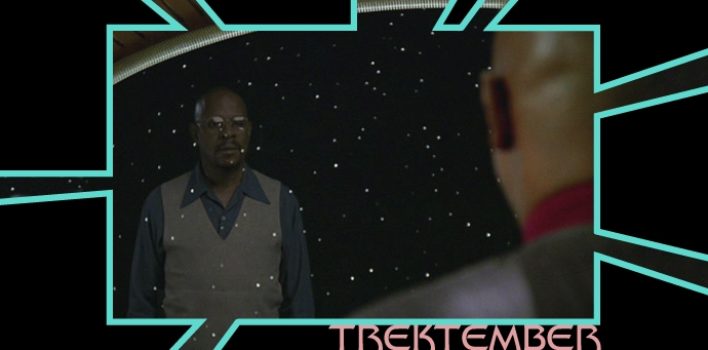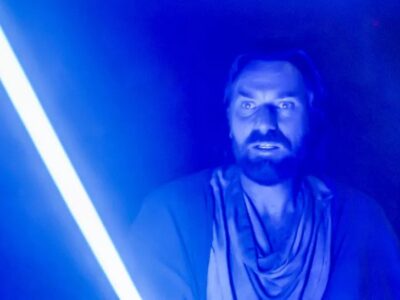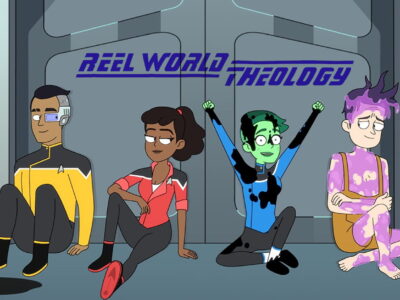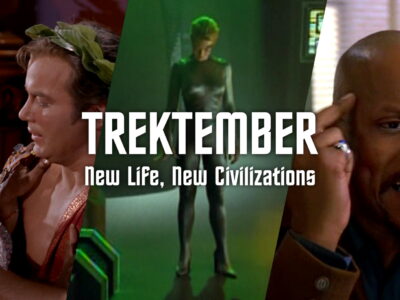Trektember: Far Beyond the Stars
“You are the dreamer…And the dream.” So the street preacher tells Sisko/Benny in the back of the ambulance when he asks (understandably), “Who am I?” Dressed in Sisko’s Starfleet uniform, he still wears the watch, ring, and glasses of Benny Russell, inhabiting, in a sense, both identities simultaneously. This merger of identities and worlds is reflected in his surroundings as well, as he looks out the back of the ambulance to see stars streaking past the windows as though he was traveling at warp speed through deep space.
He is both Sisko and Benny—the dreamer and the dream. But, in the episode’s final scene, Sisko asks which is which. Is the world of Benny Russell, as his father surmises, a dream that has helped him sort out his own reality? Or is his world the dream? “For all we know,” he says, “at this very moment, somewhere far beyond all those distant stars, Benny Russell is dreaming of us.”
Of course, we as the viewing audience know that Sisko and his world are indeed an illusion. In fact, so is Benny Russell’s. The entire thing is fiction. But Benny at least lives in our real world, a part of it as it was at one time. He therefore represents the dreaming of fiction, the writing and creating of Star Trek itself. But not only Star Trek. Benny Russell’s dreams are not only for, as K.C. Hunter put it, “a better life,” but a better future, a higher ideal for all of humanity.
Benny Russell therefore represents our human desire for something greater than our present condition, our constant need to grow beyond where we are. He is, in that sense, an embodiment of the spirit of Star Trek. Indeed, he represents the better part of our human nature.
“It’s just a photo,” Douglas Pabst tells Benny, after it becomes clear that Benny must “sleep late” on the day the writers’ photos are to be taken, so as not to reveal to his reading public that he is a black man. K.C. Hunter must do the same, a nod to Star Trek writer Dorothy “D.C.” Fontana, who was similarly coy regarding her sex early in her career. Surely viewers of the Original Series assumed D.C. Fontana was a man, just as Pabst expects readers to assume Benny Russell is white.
“I’ll try to remember that,” Benny responds, indicating that, of course, it’s not just a photo. It’s a symbol of Benny’s validity, indeed his very humanity, compromised by the views of those who wish to make him less than a man. “Boy,” the plain clothes detective calls him as he and his partner treat him with suspicion and disdain for clearly no other reason than the color of his skin.
It’s not just a photo. It’s not just a drawing of a space station under the detective’s feet. And it’s not just a story. It’s all an expression of Benny Russell’s essential humanity and dignity—which are threatened if not taken from him on a daily basis by a society that views him as unworthy of simple, basic equality.
And is it really so much to ask?
After all, it’s just a story, just a drawing, just a photo. It’s just a basic show of respect. It’s just a water fountain, just a seat on the bus, just a sandwich at a cafe. It’s just a paycheck, just a rental agreement, just a marriage license. It’s just a seat at the table, just a leadership role, just respect for a person, a neighborhood, a family. It’s just the simple recognition of the humanity of our neighbor who may not be like us but who is, fundamentally, exactly like us. Why is it something we begrudge with such cavalier ease, even today? Even in this country? Even in the Church?
It’s so much easier to other than to one another—to fear than to love.
This is the dream that Benny Russell dreams, the story that he writes. Not simply that a black man can be a captain on a space station, but that he himself can be seen as equal to his white neighbors, that indeed any human may have the same respect and dignity as that afforded to others, even when they are different in ways of which others may disapprove.
This dream is the essential dream that Jesus had for all of us as he prayed, “that they may be one,” even as he and his Father are one. It is the dream that says, “Love your neighbor as yourself.”
But dreams aren’t enough. As Picard tells us, “Wishing for a thing does not make it so.” Or, in the words of Benny Russell, “Wishing never changed a damn thing.” Dreams die without action. Achieving them requires doing. It requires tenacity—faithfulness. At the conclusion of the episode, Sisko decides not to quit, but to “stay here and finish the job I started. And if I fail…” His father completes the thought. “I have fought the good fight. I have finished the course. I have kept the faith.”
A lot of us think of “keeping the faith” as maintaining the religion. We think of it as fulfilling duties and passing on traditions. Keeping the faith means, at most, praying, reading the Bible, and attending church, perhaps evangelizing. But Paul characterizes it in very active terms.
I was recently with pastor and author Doug Pagitt, who made the distinction between “belief” and “believing.” A belief, Pagitt says, is a noun. It’s an idea you hold onto. Believing on the other hand, is a verb. It is something you do. Keeping the faith, in this context, is not about holding the right beliefs, but believing—doing the right things, the things that will bring about a better world, that will cause us to live as both the dreamer and the dream.
“Write the words,” the street preacher says to “Brother Benny.” He tells Benny that, while he speaks for the Prophets through a religious act, Benny must do the same through what some would call a secular act. In fact, though, Benny’s actions are no less religious as they are the living out of the dream. In this context, the writing of science fiction stories becomes a sacred act—a holy calling.
If each of us could see this about our own lives, our own families, our own communities, our own jobs—that we are the dreamer and the dream, that we keep the faith, if we are to keep it at all, in every area of life, what a difference that might make. What a difference it might make if we could all see the sacredness of that which may seem to be mundane or even trivial.
“The public,” Pabst says, dismissing the importance of his own publication, “is simply going to have to get along without any incredible tales this month.” But Benny knows they’re not just incredible tales. For him especially, the story of Captain Sisko and Deep Space Nine is the story of a future he must believe is not only possible, but will come to pass—a world that must somehow be real somewhere. In one of the most powerful moments in Star Trek history, he declares not just the value of his stories, but his own personhood.
I am a human being, dammit! You can deny me all you want but you cannot deny Ben Sisko. He exists! That future, that space station, all those people, they exist! In here. In my mind. I created it. And every one of you know it! You read it! It’s here. You hear what I’m telling you? You can pulp a story, but you cannot destroy an idea. Don’t you understand? That’s ancient knowledge. You cannot destroy an idea! That future, I created it, and it’s real. Don’t you understand? It is real! I created it and it’s real! It’s real!
—Benny
For Benny, Deep Space Nine is real, not just in the hope that a black man can one day be a leader, but in the deep, human truth, the “ancient knowledge,” as he puts it, that there is an essential dignity in all human beings. It is there despite every boundary we might draw, every wall we might build, every judgment we might make against a person’s family or gender or expression of self or faith. It is there because it is the Imago Dei—the image of the Divine in all humanity. It is the reality that every person is worthy of, desperately needy for, and incapable of earning love. It is therefore the greatest truth of our existence: that none of us is above another, and that all can be seen, heard, and known as valuable children of God. We are the dreamer and the dream. And the dream is Love. It’s the simple idea that we should all love one another.
It’s just a photo, just a story, just a bus seat, just a pronoun, just a name. It’s just another of a countless number of expressions of essential humanity. It’s a small thing. And it’s everything. And if we live it, day by day, in all those small things, then one day we can look around us and see that the dream is real.
• • •
For more about “Far Beyond the Stars,” click here to read Kevin’s companion review of the episode.








Pingback: Trektember: It’s Only a Paper Moon | Reel World Theology